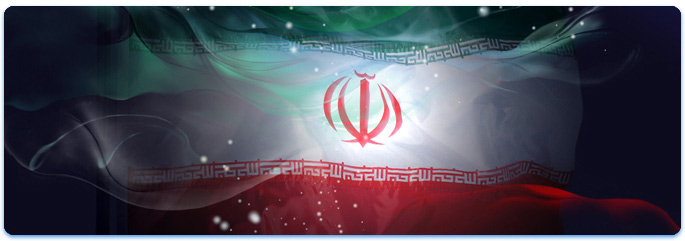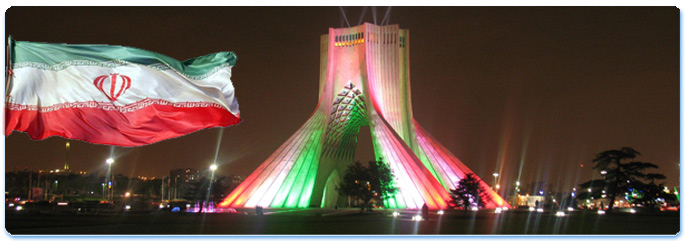- Flag Description and Meaning
The design of the National flag of Iran consists of three identical horizontal bands of green on top, white in between, and red below. The National emblem which represents the name of Allah is placed on the center of the white band. The words "Allah-o-Akbar (God is great) is printed in white Arabic script and is repeated 22 times on the center border of the green and red band. The length of the flag is precisely twice the overall width with a ratio of 4:7.
The three colors of the National flag of Iran have symbolic connotations. The green stripe stand for growth and prosperity, white stands for peace and red is the color of the blood shed by the martyrs for the country's freedom.
The National emblem on the flag center comprises of four crescents and a sword. The four crescents of the emblem form the word Allah (God) and the five parts of the emblem represent the five pillars of Islam. On top of the sword, which symbolizes a strong and powerful sovereign state, is a tashdid. The tashdid is used in Arabic writing to double a letter and in this context it means to double the strength of the sword. The tulip shape of the emblem was chosen in remembrance of the young martyrs of Islamic Republic of Iran.
Colour | Symbolism |
Green | Vitality and growth |
White | Honesty, purity, and peace |
Red | Valour and sacrifice |
- History of the Iranian Flag
The best-known symbol of Iran in recent centuries has been the Lion and Sun motif, which is a graphic expression of the astrological configuration of the sun in the sign of Leo, although both celestial and animal figures have long and independent histories in Iranian heraldry.
Late in the nineteenth century the Lion and Sun motif was combined with an earlier scimitar motif and superimposed on a tricolour of green, white, and red. With minor modifications, this remained the official flag until the revolution of 1979.
Since Islam strictly prohibited figurative and expressive symbols as idol worship, all the traditional emblems used in Iranian flags were eliminated. Throughout this period there was no flag specific to Iran, although the use of Islamic banners was common.
In the constitution of 1980, Parliament changed the flag and seal of state. The Lion and Sun was succeeded by a new symbol, designed by Hamid Nadimi and officially approved by Ayatollah Khomeini on 9 May 1980, consisting of four crescents and a line. The four crescents form the word Allah: read from right to left the first crescent is the letter aleph, the second crescent is the first laam; the vertical line is the second laam, and the third and fourth crescents together form the heh.
Above the central stroke is a tashdid (a diacritical mark indicating gemination) resembling a letter W. The tulip shape of the emblem as a whole memorializes those who have died for Iran and symbolizes the values of patriotism and self-sacrifice, building on a legend that red tulips grow from the shed blood of martyrs. A further change to the flag following the revolution was the addition of writing to the inner edges of the green and red bands, reading Allahu Akbar ("God is great") in a stylized version of the Kufic script used for the Qur'an. There are 22 copies of this inscription, in two rows of eleven, symbolic of the 22nd day of the 11th month (Bahman) in the Persian calendar—the date of the Islamic revolution (22 Bahman 1357 = 11 February 1979 CE) that overthrew the Pahlavi dynasty. This addition of writing renders the flag non-reversible. By decree the Lion and Sun was removed from public spaces and government organizations and replaced by the present-day emblem of Iran.


